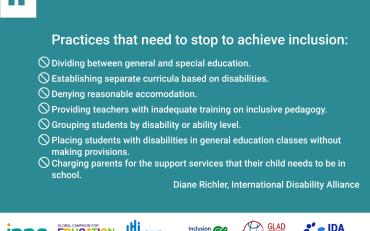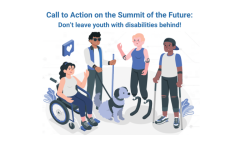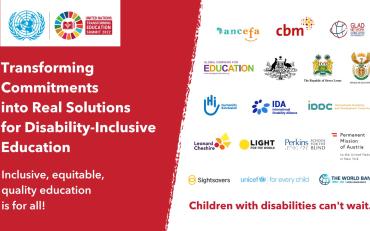The International Disability and Development Consortium (IDCC), the International Disability Alliance (IDA), the Global Action on Disability (GLAD) Network and the Global Coalition for Education (GCE), call for the international community to commit to ensuring disability-inclusive quality education, including in early childhood, in global efforts to mobilise action ahead of the Transforming Education Pre-Summit (28th-30th June) and Summit (19th September). We call on the TES Secretariat, UN Member States, civil society partners and other education actors to ensure that the rights of children and youth with disabilities, as enshrined in the UN Convention on the Rights of Persons with Disabilities (CRPD), and the promise of Leave No One Behind are at the heart of discussions and outcomes of the TES. Education systems cannot be transformed to be inclusive without sufficient and targeted financing; accessible digital learning; supported education staff; and inclusive teaching approaches for lifelong learning and work.
The full statement can be read in Word and PDF and a shortened version in Word and PDF.
The Full Statement
The International Disability and Development Consortium (IDDC), the International Disability Alliance (IDA), the GlobalAction on Disability (GLAD) Network and the Global Campaign for Education (GCE), calls for the international community to ensure disability inclusive quality education, including in early childhood, is at the heart of global action ahead of the Transforming Education Summit in September.
We welcome the UN Secretary-General’s convening of the Transforming Education Summit (TES) to galvanise political action to recover from COVID-19 learning losses and revitalise efforts to achieve Sustainable Development Goal (SDG) 4 by 2030.
The TES and pre-Summit offer critical opportunities to better understand the changes and investments needed to build transformative inclusive education systems. We call on the TES Secretariat, UN Member States, civil society partners and other education actors to uphold the rights of children and youth with disabilities, as enshrined in the UN Convention on the Rights of Persons with Disabilities (CRPD), ensuring the promise of Leave No One Behind is integral to discussions and outcomes of the TES.
To achieve the human right of inclusive education for all learners, actions for the inclusion of groups most at risk of experiencing discrimination and marginalisation must be fully embedded in all five TES Thematic Action Tracks. Education systems cannot be transformed to be inclusive without sufficient and targeted financing; accessible digital learning; supported education staff; and inclusive teaching approaches for lifelong learning and work.
The situation is urgent for all learners and especially those with disabilities. Prior to the pandemic, 240 million children with disabilities[1] were already most likely to be excluded from quality education.[2] They were not only less likely to attend or complete school, but also more likely to be illiterate than children without disabilities.1 This is especially the case for girls with disabilities.
Barriers to learning for children and youth with disabilities are compounded by multiple factors including poverty (both a cause and consequence of disability[3]); deeply entrenched social stigma even among educators, experts, and policymakers; inadequate and inaccessible learning facilities; a lack of reasonable accommodations, a lack of support services for equitable access to education; and policy environments that do not align with the CRPD. These inequalities are worsened in situations of emergencies and protracted crises where the right to inclusive quality education for children with disabilities is yet to be realised.
Pandemic-related school closures have led to lower quality learning, increased exclusion, marginalisation, and greater levels of poverty.[4] In one survey, 17% of respondents with disabilities had dropped out of education during the pandemic.[5] Children with intellectual disabilities were disproportionately excluded in remote learning. In addition, some children will have new cognitive impairments post-COVID, and it is not yet known whether these are temporary or permanent. Education recovery must compensate for lost learning, open pathways into better and more accessible learning systems and support young people's process of healing.
Implementing action
Through the 2030 Agenda, the international community made a commitment to leave no one behind and to prioritise those furthest behind.[6] SDG 4 and the Incheon Declaration and Framework for Action saw commitments to twelve years of free, publicly funded, equitable quality primary and secondary education for all. Building a truly inclusive education system is the only way to ensure children with disabilities achieve their full potential and ultimately ensure the realisation of SDG4.[7]
We endorse the recommendations identified within Thematic Action Track 1 ‘Inclusive, equitable, safe and healthy schools’ and the five key actions to advance inclusion and equity.[8] As highlighted in the discussion paper, political leadership, sufficient financing, legislation, institutional frameworks and capacity, and a steady focus on making systems equitable and inclusive will be needed for these actions to be advanced in practice. We also recommend the following priorities be recognised at the TES to ensure action towards more inclusive education systems:
1. A twin-track approach
A twin-track approach to disability inclusion should be implemented, mainstreaming inclusion as well as providing targeted support in general education settings to those at highest risk of exclusion. This includes strong school-based support systems which provide reasonable accommodation and supports learners with a diverse range of learning needs. Governments must dismantle structures of discrimination and marginalisation, including phasing out segregated and/or special education settings and ensure the provision of inclusive education, including bilingual sign language schools.
2. Remove institutional and interlinking barriers
Inclusion and equity are cross-cutting principles that must be applied across all areas of education systems. For governments and other stakeholders joining the TES, this means the application of an intersectional lens across all Thematic Action Tracks to identify factors that lead to exclusion and inequality. Political and financial action should address the multiple and intersecting barriers to learning and invest in evidence-based interventions that deliver transformative education for all. For example, developing equitable financing or digital learning options might require identifying the specific needs of migrant girls with disabilities in offline rural schools. Governments should prioritise addressing institutional barriers, while implementing inclusive policies across the whole education spectrum, from early childhood development to higher education and technical and vocational education and training.
3. Improve evidence and data
Education policy should be based on reliable evidence. This requires governments to urgently address gaps in data collection and analysis so the most marginalised are not invisible to policy makers. They must strengthen national data systems, surveys, and administrative systems by employing standard disability identification tools to increase the availability, quality and comparability of data, and build capacity to disaggregate data by sex, age, disability, geography and other intersecting dimensions. Disaggregated data must also inform the equitable allocation of resources.
4. Invest in inclusive teacher training
Inclusive education requires investments in pre- and in-service teacher training in disability inclusive pedagogy to ensure staff identify and adapt practices to meet diverse learning needs. To improve preparedness to crises like the COVID-19 pandemic, training for teachers and school staff needs to include disability- inclusive approaches to distance-learning, using various channels and high-, low-, and no- tech solutions. Staff need to be supported in developing skills to effectively use digital technology in teaching. Additionally, governments should build evidence around the effectiveness of teaching by improving data collection and analysis on recruitment and retention of teachers, especially teachers from minority groups, female teachers and teachers with disabilities.
5. Tackle the digital divide and ensure technology is accessible
Education technology should include quality, accessible and affordable modes of digital and remote technologies and avoid over-reliance on single-technology solutions. Accessibility should be embedded into EdTech productions and eLearning options. The pandemic exacerbated existing digital inequalities – whilst more than 90% of countries offered some form of distance learning, at least 31% of children were unable to benefit from this due to limited access to internet and technology, inaccessible tools, or lack of access to tools.[9] In one survey 64% of respondents with disabilities said that at least one of the platforms used for online education was inaccessible.[10] Transforming education must also address gendered and ableist differences in access to digital learning through a disability-inclusive and gender-responsive approach to ICT development to reduce the digital divide.[11]
6. Ensure adequate, sustainable, and equitable funding
Education transformation cannot be achieved without increased equitable and efficient financing. Investments into increasing the quality of education for children with disabilities can improve the overall standard of education and teaching for all learners.[12] National education budgets should be protected and increased to universally agreed benchmarks, with consideration of the costs required when budgeting for inclusion. It is critical to recognise the cost effectiveness of budgeting for disability inclusion. This is true in terms of the return on investment when children with disabilities can continue with their education and contribute to society.[13] It is also cost effective to plan for disability inclusion from the beginning, as the cost of retrospectively making schools more accessible after construction can be as much as 20% of the original cost.[14]
7. Engage people with disabilities
The TES is an opportunity to engage a broad range of education actors, including people with disabilities, their representative organizations and their families, through multi-sectoral, intergenerational, and inclusive dialogue to identify realistic solutions. Organisations of people with disabilities, teachers with disabilities, and children and youth with disabilities, their families, and their networks are best placed to recommend inclusive best practices and must be meaningfully engaged in the preparatory processes, consultations, and outcomes of the TES. Ensuring their participation not only is key to developing and implementing relevant and sustainable solutions, but also an obligation under the CRPD.
Fulfil the commitments made to people with disabilities
The UN’s Disability Inclusion Strategy (UNDIS) outlines the need to systematically embed the rights of people with disabilities across all the work of the UN system. TES should ensure all its events, consultations, platforms, and forums (online and physical) are accessible to all. This should include accessibility features, such as sign language interpretation, captioning, and remote participation options, as well as access to reasonable accommodation to ensure people with disabilities can effectively participate.
Earlier this year, we saw governments, donors and civil society partners make over two hundred commitments towards inclusive education at the Global Disability Summit. As the international community comes together for the TES, we call for these commitments to be honoured.
Reimagining the future for education requires a foundational commitment to inclusion and equity. The TES must ensure actions advance on SDG4 through inclusive COVID-19 recovery, resilient and inclusive education systems, equitable financing, and the removal of institutional and social barriers to inclusion so every child can benefit from quality education.
[1] United Nations Children’s Fund (2021). Seen, Counted, Included: Using data to shed light on the well-being of children with disabilities
[2] The Education Commission, (2016). The Learning Generation: investing in education for a changing world.
[4] Humanity & Inclusion (2020) Let’s break silos now! Achieving disability-inclusive education in a post-COVID world.
[5] IDA (2021) Survey on the Experience of Persons with Disabilities Adapting to the COVID-19 Global Pandemic
[6] UN General Assembly (2015) Transforming our world: the 2030 Agenda for Sustainable Development
[8]TES Action Track 1 on Inclusive, equitable, safe and healthy schools Discussion paper (3rd June 2022)
[9] UNICEF (2020) Covid-19: Are children able to continue learning during school closures? A global analysis of the potential reach of remote learning policies using data from 100 countries
[10] IDA (2021) Survey on the Experience of Persons with Disabilities Adapting to the COVID-19 Global Pandemic
[11] Humanity & Inclusion (2021) Information and Communication Technology (ICTs) and Inclusive Education
[12] Watters, L. (2022) Value for Money
[13] Banks, L.M. and Polack, S. (2014) The Economic Costs of Exclusion and Gains of Inclusion of People with Disabilities: Evidence from Low and Middle Income Countries. ICED Research Report
[14] United Nations Children's Fund (2013) The State of the World’s Children: Children with Disabilities



